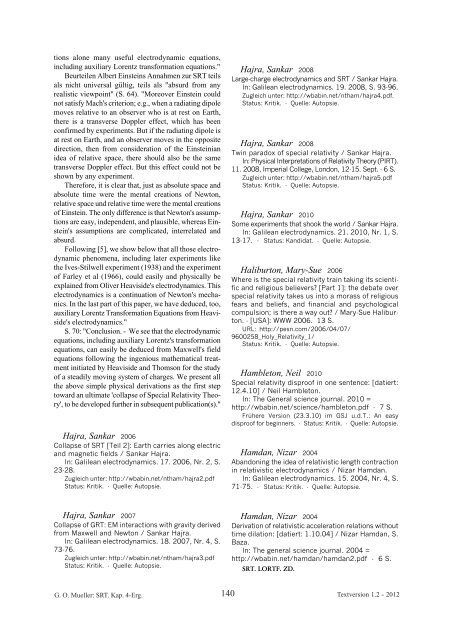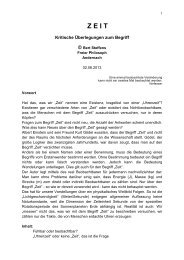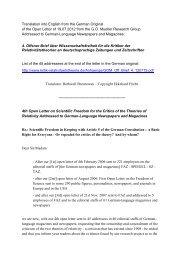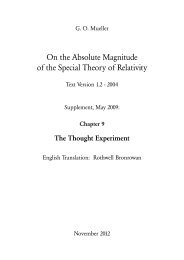2394 weitere kritische Veröffentlichungen - Kritische Stimmen zur ...
2394 weitere kritische Veröffentlichungen - Kritische Stimmen zur ...
2394 weitere kritische Veröffentlichungen - Kritische Stimmen zur ...
Sie wollen auch ein ePaper? Erhöhen Sie die Reichweite Ihrer Titel.
YUMPU macht aus Druck-PDFs automatisch weboptimierte ePaper, die Google liebt.
tions alone many useful electrodynamic equations,<br />
including auxiliary Lorentz transformation equations."<br />
Beurteilen Albert Einsteins Annahmen <strong>zur</strong> SRT teils<br />
als nicht universal gültig, teils als "absurd from any<br />
realistic viewpoint" (S. 64). "Moreover Einstein could<br />
not satisfy Mach's criterion; e.g., when a radiating dipole<br />
moves relative to an observer who is at rest on Earth,<br />
there is a transverse Doppler effect, which has been<br />
confirmed by experiments. But if the radiating dipole is<br />
at rest on Earth, and an observer moves in the opposite<br />
direction, then from consideration of the Einsteinian<br />
idea of relative space, there should also be the same<br />
transverse Doppler effect. But this effect could not be<br />
shown by any experiment.<br />
Therefore, it is clear that, just as absolute space and<br />
absolute time were the mental creations of Newton,<br />
relative space und relative time were the mental creations<br />
of Einstein. The only difference is that Newton's assumptions<br />
are easy, independent, and plausible, whereas Einstein's<br />
assumptions are complicated, interrelated and<br />
absurd.<br />
Following [5], we show below that all those electrodynamic<br />
phenomena, including later experiments like<br />
the Ives-Stilwell experiment (1938) and the experiment<br />
of Farley et al (1966), could easily and physically be<br />
explained from Oliver Heaviside's electrodynamics. This<br />
electrodynamics is a continuation of Newton's mechanics.<br />
In the last part of this paper, we have deduced, too,<br />
auxiliary Lorentz Transformation Equations from Heaviside's<br />
electrodynamics."<br />
S. 70: "Conclusion. - We see that the electrodynamic<br />
equations, including auxiliary Lorentz's transformation<br />
equations, can easily be deduced from Maxwell's field<br />
equations following the ingenious mathematical treatment<br />
initiated by Heaviside and Thomson for the study<br />
of a steadily moving system of charges. We present all<br />
the above simple physical derivations as the first step<br />
toward an ultimate 'collapse of Special Relativity Theory',<br />
to be developed further in subsequent publication(s)."<br />
Hajra, Sankar 2006<br />
Collapse of SRT [Teil 2]: Earth carries along electric<br />
and magnetic fields / Sankar Hajra.<br />
In: Galilean electrodynamics. 17. 2006, Nr. 2, S.<br />
23-28.<br />
Zugleich unter: http://wbabin.net/ntham/hajra2.pdf<br />
Status: Kritik. - Quelle: Autopsie.<br />
Hajra, Sankar 2007<br />
Collapse of GRT: EM interactions with gravity derived<br />
from Maxwell and Newton / Sankar Hajra.<br />
In: Galilean electrodynamics. 18. 2007, Nr. 4, S.<br />
73-76.<br />
Zugleich unter: http://wbabin.net/ntham/hajra3.pdf<br />
Status: Kritik. - Quelle: Autopsie.<br />
G. O. Mueller: SRT. Kap. 4-Erg.<br />
140<br />
Hajra, Sankar 2008<br />
Large-charge electrodynamics and SRT / Sankar Hajra.<br />
In: Galilean electrodynamics. 19. 2008, S. 93-96.<br />
Zugleich unter: http://wbabin.net/ntham/hajra4.pdf.<br />
Status: Kritik. - Quelle: Autopsie.<br />
Hajra, Sankar 2008<br />
Twin paradox of special relativity / Sankar Hajra.<br />
In: Physical Interpretations of Relativity Theory (PIRT).<br />
11. 2008, Imperial College, London, 12-15. Sept. - 6 S.<br />
Zugleich unter: http://wbabin.net/ntham/hajra5.pdf<br />
Status: Kritik. - Quelle: Autopsie.<br />
Hajra, Sankar 2010<br />
Some experiments that shook the world / Sankar Hajra.<br />
In: Galilean electrodynamics. 21. 2010, Nr. 1, S.<br />
13-17. - Status: Kandidat. - Quelle: Autopsie.<br />
Haliburton, Mary-Sue 2006<br />
Where is the special relativity train taking its scientific<br />
and religious believers? [Part 1]: the debate over<br />
special relativity takes us into a morass of religious<br />
fears and beliefs, and financial and psychological<br />
compulsion; is there a way out? / Mary-Sue Haliburton.<br />
- [USA]: WWW 2006. 13 S.<br />
URL: http://pesn.com/2006/04/07/<br />
9600258_Holy_Relativity_1/<br />
Status: Kritik. - Quelle: Autopsie.<br />
Hambleton, Neil 2010<br />
Special relativity disproof in one sentence: [datiert:<br />
12.4.10] / Neil Hambleton.<br />
In: The General science journal. 2010 =<br />
http://wbabin.net/science/hambleton.pdf - 7 S.<br />
Frühere Version (23.3.10) im GSJ u.d.T.: An easy<br />
disproof for beginners. - Status: Kritik. - Quelle: Autopsie.<br />
Hamdan, Nizar 2004<br />
Abandoning the idea of relativistic length contraction<br />
in relativistic electrodynamics / Nizar Hamdan.<br />
In: Galilean electrodynamics. 15. 2004, Nr. 4, S.<br />
71-75. - Status: Kritik. - Quelle: Autopsie.<br />
Hamdan, Nizar 2004<br />
Derivation of relativistic acceleration relations without<br />
time dilation: [datiert: 1.10.04] / Nizar Hamdan, S.<br />
Baza.<br />
In: The general science journal. 2004 =<br />
http://wbabin.net/hamdan/hamdan2.pdf - 6 S.<br />
SRT. LORTF. ZD.<br />
Textversion 1.2 - 2012





